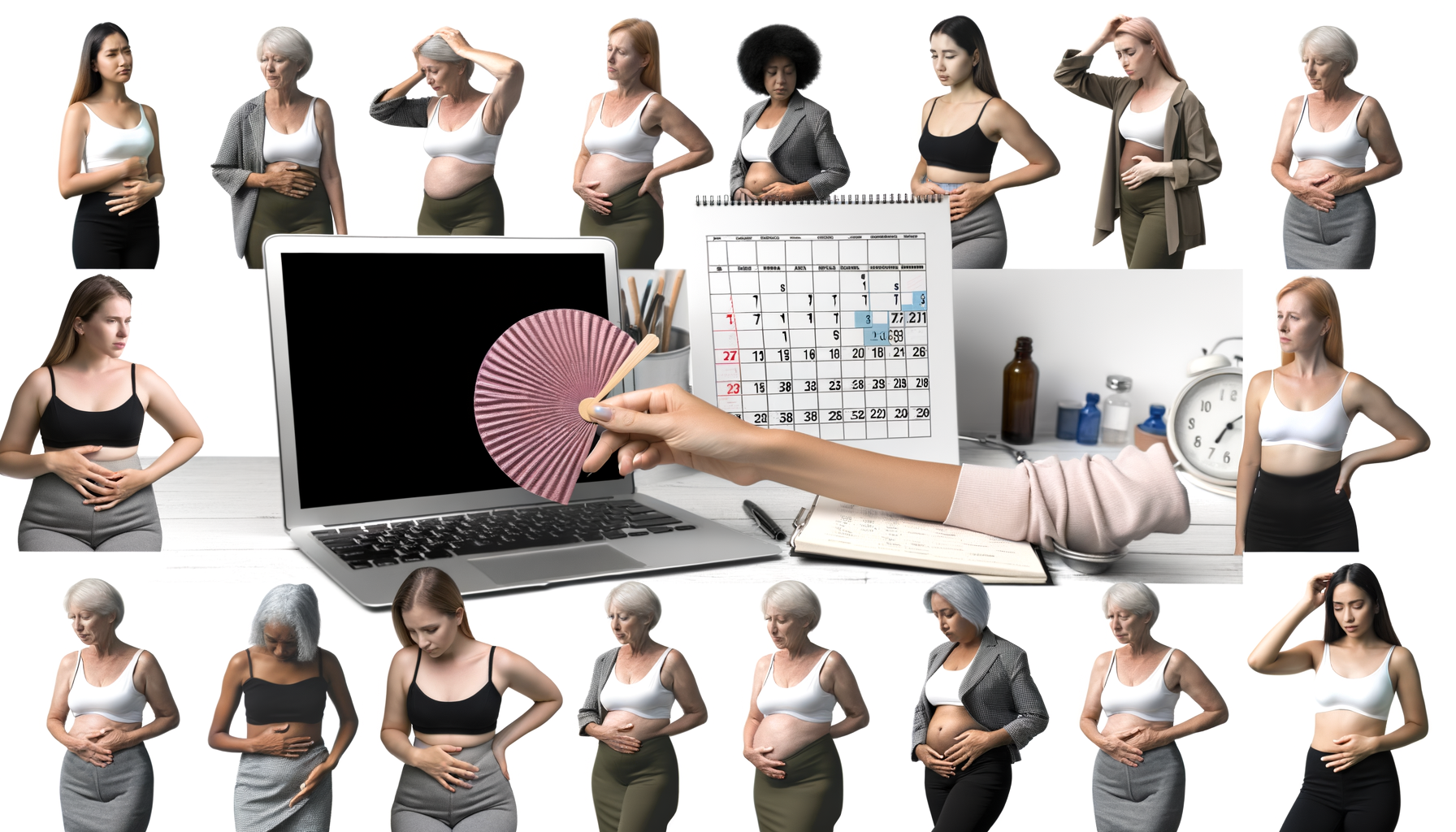Menopause and Age-Related Changes
Menopause marks a significant transition in the lives of individuals assigned female at birth (AFAB), signifying the end of the reproductive years. This natural biological process typically occurs between the ages of 40 and 65, with the average onset around 51 years in the United States. Menopause is clinically diagnosed after a person has gone 12 consecutive months without a menstrual period. The journey to menopause can be gradual, with the perimenopausal phase leading to changes in menstrual patterns, hot flashes, and other symptoms that signal the approaching end of menstruation.
Factors Influencing the Timing of Menopause
The timing of menopause can be influenced by a variety of factors. Lifestyle choices, such as smoking, can accelerate the onset, while certain medical interventions like chemotherapy or oophorectomy can induce premature menopause. On the other hand, factors like ethnicity and body mass index have also been observed to impact the age at which menopause begins. It’s important to note that while the average age of menopause is 51, some may experience it earlier or later, with a small percentage entering menopause after the age of 55.
The Role of Genetics, Health, and Lifestyle
Genetics play a crucial role in determining the age of menopause onset, often mirroring the experiences of one’s mother or close female relatives. Health conditions, particularly those affecting the ovaries or endocrine system, can alter the expected timeline. Lifestyle factors, including diet, exercise, and stress levels, can also influence menopausal symptoms and their severity. It is essential for individuals to maintain open communication with healthcare providers to navigate this transition effectively, considering both the genetic predispositions and the modifiable lifestyle factors that contribute to their menopausal experience.
Early Signs and Symptoms of Menopause (Ages 40-45)
Identifying Early Menopause and Its Causes
Early menopause, which occurs between the ages of 40 and 45, can be a natural variation of the aging process or induced by factors such as medical treatments, autoimmune diseases, or genetic predispositions. Premature menopause, on the other hand, refers to the cessation of menstruation before the age of 40. It is crucial for individuals experiencing symptoms of early menopause to consult with a healthcare provider, as it can lead to health complications and affect fertility.
Symptoms Unique to Early Menopause
Early menopause can manifest through a variety of symptoms, some of which may be unique to this earlier transition. These include irregular periods, hot flashes, night sweats, mood swings, and vaginal dryness. Additionally, early menopause can lead to long-term effects such as decreased bone density, increased cardiovascular risk, and changes in sexual function. Mental health can also be impacted, with potential risks for cognitive decline and depression.
Medical Evaluation and Treatment Options
There is no definitive test for early menopause, but blood tests measuring follicle-stimulating hormone (FSH) levels can provide indications. Hormone replacement therapy (HRT) is often recommended to alleviate symptoms and reduce long-term health risks. However, HRT carries its own risks and should be discussed with a healthcare professional. Lifestyle changes, such as diet and exercise, can also play a role in managing symptoms.
Fertility Considerations and Options
Early menopause significantly affects fertility, as the ovaries cease producing eggs. This can have profound psychological impacts for those wishing to conceive. Fertility preservation techniques, such as egg freezing, may be an option for those who anticipate early menopause due to medical treatments or genetic factors. It is important to discuss these options with a fertility specialist to understand the potential outcomes and make informed decisions.
Perimenopause: The Transitional Phase (Late 40s)
Defining Perimenopause and Its Duration
Perimenopause, often referred to as the “menopause transition,” is the period leading up to menopause. It marks the end of reproductive years and is characterized by hormonal fluctuations as the body begins to produce less estrogen and progesterone. This phase typically starts in a person’s late 40s and can last anywhere from 7 to 14 years. During perimenopause, menstruation becomes irregular and unpredictable, signaling the gradual approach to menopause, which is officially diagnosed after twelve consecutive months without a period.
Symptoms and Hormonal Fluctuations
The hallmark of perimenopause is the fluctuation of hormone levels, particularly estrogen. These fluctuations can lead to a variety of symptoms, including:
- Hot flashes and night sweats
- Mood swings and irritability
- Vaginal dryness and discomfort during sex
- Sleep disturbances, such as insomnia
- Changes in libido or sexual desire
- Difficulty concentrating and memory lapses
- Hair loss or thinning
- Increased heart rate or palpitations
- Urinary urgency or incontinence
These symptoms are a direct result of the body’s response to the lower and inconsistent levels of estrogen and progesterone.
Fertility During Perimenopause
While fertility naturally declines with age, it is still possible to become pregnant during perimenopause. Ovulation may occur sporadically, and periods, though irregular, do happen. Therefore, if pregnancy is not desired, effective contraception should be used until menopause has been confirmed by a full year without menstruation.
Managing Symptoms and Contraception
Managing the symptoms of perimenopause often involves a combination of lifestyle adjustments, hormone therapy (HT), and non-hormonal medical treatments. Lifestyle strategies include:
- Maintaining a healthy diet and weight
- Regular physical activity
- Stress-reduction techniques such as yoga or meditation
- Ensuring adequate sleep
For those who need additional relief, hormone therapy may be prescribed to stabilize hormone levels and alleviate symptoms. However, HT is not suitable for everyone and should be discussed with a healthcare provider to weigh the benefits against potential risks, such as heart disease and certain cancers.
Regarding contraception, barrier methods, intrauterine devices (IUDs), and low-dose hormonal contraceptives can be effective options. It’s important to consult with a healthcare professional to choose a method that is appropriate for one’s age, health status, and symptom management needs.
In summary, perimenopause is a significant transitional phase that requires understanding and management of symptoms, as well as careful consideration of fertility and contraception. With the right support and treatment, individuals can navigate this phase with greater ease and comfort.

Navigating Menopause in the Early 50s
Transitioning from Perimenopause to Menopause
For many individuals assigned female at birth (AFAB), the early 50s mark a significant transition as the body shifts from perimenopause to menopause. This period is characterized by the cessation of ovarian egg release and a significant drop in estrogen production. The journey from perimenopause to menopause can span several years, during which menstrual cycles become increasingly erratic before stopping altogether. Once a full year has passed without a menstrual period, a woman is considered to have reached menopause. The experience of this transition can vary widely, with some navigating it with minimal discomfort while others may find the symptoms more challenging.
Common Symptoms and Their Impact
The symptoms experienced during the early 50s can be a continuation of those encountered during perimenopause but often become more pronounced. Common symptoms include:
- Hot flashes: Sudden feelings of warmth, often accompanied by flushing and sweating.
- Vaginal dryness: Decreased estrogen levels can lead to discomfort and dryness in the vaginal area.
- Sleep disturbances: Difficulty falling or staying asleep, often exacerbated by night sweats.
- Mood swings: Emotional variability that can impact daily life and relationships.
These symptoms can significantly impact quality of life, affecting personal relationships, professional performance, and overall well-being.
Treatment and Hormone Therapy Options
Addressing the symptoms of menopause in the early 50s involves a personalized approach, often including lifestyle modifications, non-hormonal remedies, and potentially hormone therapy (HT). HT, which may consist of estrogen alone or in combination with progesterone, is considered the most effective treatment for hot flashes and other menopausal symptoms. However, it is not without risks and should be carefully considered in consultation with a healthcare provider. The decision to use HT should take into account personal health history, the severity of symptoms, and the potential for side effects such as increased risk of breast cancer, cardiovascular disease, and blood clots.
Non-hormonal options, such as selective serotonin reuptake inhibitors (SSRIs), may provide relief for some symptoms and are particularly useful for those who cannot or choose not to use HT. Additionally, lifestyle interventions, including regular exercise, a balanced diet, and stress-reduction techniques, can play a crucial role in managing menopausal symptoms.
Ultimately, navigating menopause in the early 50s requires open communication with healthcare professionals, a thorough understanding of the available treatment options, and a commitment to finding the most suitable approach for each individual’s unique circumstances.
Postmenopausal Phase and Continued Symptoms (Age 55+)
Defining the Postmenopausal Stage
The postmenopausal stage marks the end of a woman’s reproductive years, signifying a permanent cessation of menstrual periods. This phase begins after a woman has experienced 12 consecutive months without menstruation, typically occurring between the ages of 45 and 55. However, the transition can vary widely, with some entering postmenopause earlier or later than this age range. During this stage, the ovaries have significantly reduced their production of estrogen and progesterone, hormones that were previously pivotal in regulating the menstrual cycle and fertility.
Persistent Symptoms After Menopause
While many may believe that the conclusion of menopause brings an end to its associated symptoms, this is not always the case. Postmenopausal women can continue to experience symptoms such as:
- Hot flashes and night sweats, which can persist and disrupt sleep patterns.
- Mood changes, including irritability and mood swings, which may affect mental well-being.
- Vaginal dryness, leading to discomfort and potential issues with sexual activity.
- Difficulty sleeping, often as a result of night sweats or other discomforts.
- Urinary problems, such as increased frequency or urgency, sometimes leading to incontinence.
These symptoms can be mild for some, but for others, they may be severe enough to impact daily life and warrant medical attention.
Health Risks and Preventive Measures
Postmenopause brings an increased risk for certain health conditions, primarily due to the lower levels of protective hormones. Key health risks include:
- Osteoporosis: The decline in estrogen can lead to a decrease in bone density, heightening the risk of fractures.
- Cardiovascular disease: Estrogen’s protective effects on the heart and blood vessels diminish, increasing the risk of heart disease and stroke.
To mitigate these risks, preventive measures are crucial:
- Maintaining a healthy diet rich in calcium and vitamin D to support bone health.
- Engaging in regular weight-bearing exercise to strengthen bones and improve cardiovascular health.
- Undergoing regular health screenings, including bone density tests and cholesterol checks.
- Discussing with healthcare professionals the potential need for medications to prevent bone loss or manage other postmenopausal symptoms.
It is essential for postmenopausal women to maintain open communication with their healthcare providers to manage symptoms effectively and take proactive steps to safeguard their health.
Late Onset of Menopause and Its Advantages (Beyond 55)
Understanding Late Menopause
Menopause typically begins between the ages of 40 and 65, marking the end of a woman’s reproductive years. However, some women experience what is known as late menopause, which occurs beyond the age of 55. This phenomenon is characterized by the continuation of menstrual cycles and the production of ovarian hormones well into the later years of life. While the average age of menopause is between 45 and 55, late menopause can be influenced by a variety of factors, including genetics, lifestyle, and overall health.
Health Benefits Associated with Late Menopause
Experiencing menopause at a later age can offer several health advantages. Studies have linked late menopause to a lower risk of osteoporosis, as prolonged exposure to estrogen helps maintain bone density. Additionally, late menopause has been associated with a reduced risk of cardiovascular diseases, such as heart attacks and strokes. The extended presence of estrogen is believed to offer protective effects on the heart and blood vessels. Furthermore, research suggests that women who undergo menopause later may have a longer life expectancy, potentially due to the protective benefits of estrogen on various bodily systems.
Managing Persistent Menopausal Symptoms
Despite the benefits, late menopause can also mean a prolonged experience of menopausal symptoms such as hot flashes, mood swings, and vaginal dryness. It is estimated that up to 40 percent of women aged 60 to 65 still experience hot flashes. For those dealing with persistent symptoms, it is crucial to consult healthcare professionals for appropriate management strategies. Options may include hormone therapy, lifestyle modifications, and other treatments tailored to individual needs. Additionally, it is important to be vigilant about health screenings, as the risk for certain conditions, like breast cancer, may increase with extended exposure to estrogen.
In conclusion, late onset of menopause can offer significant health benefits, but it also requires careful management of ongoing symptoms. Women experiencing menopause beyond the age of 55 should work closely with their healthcare providers to ensure a personalized approach to their well-being during this stage of life.
Personalizing Menopause: Individual Experiences and Professional Guidance
Variability in Menopause Experiences
Menopause is a unique journey for every woman, with a wide array of experiences that can vary significantly in terms of onset, duration, and symptomatology. While some women may transition through menopause with minimal discomfort, others may find their daily lives disrupted by a range of symptoms. These can include hot flashes, night sweats, mood swings, and changes in sexual function, among others. The intensity and impact of these symptoms can be influenced by a multitude of factors, including genetics, lifestyle, and overall health.
The Importance of Consulting Healthcare Professionals
Given the individual nature of menopause, it is crucial for women to seek guidance from healthcare professionals who can provide personalized care. Consulting with a gynecologist, endocrinologist, or a menopause specialist can help women understand their symptoms, receive accurate diagnoses, and explore treatment options. Healthcare professionals can also offer support and resources for managing menopause-related changes, ensuring that women do not navigate this complex phase alone.
Diagnostic Tests and Personalized Treatment Plans
To tailor menopause management effectively, healthcare providers may recommend a series of diagnostic tests. These can include blood tests to measure hormone levels, bone density scans for assessing osteoporosis risk, and mammograms for breast health monitoring. Based on the results, a personalized treatment plan can be developed. This plan may incorporate hormone therapy, non-hormonal medications, lifestyle modifications, and alternative therapies. The goal is to address the specific needs and preferences of each woman, optimizing her health and quality of life during and after the menopause transition.
Ultimately, the approach to managing menopause should be as unique as the women experiencing it. By combining professional medical advice with a clear understanding of personal health histories and preferences, women can navigate menopause with confidence and support.











